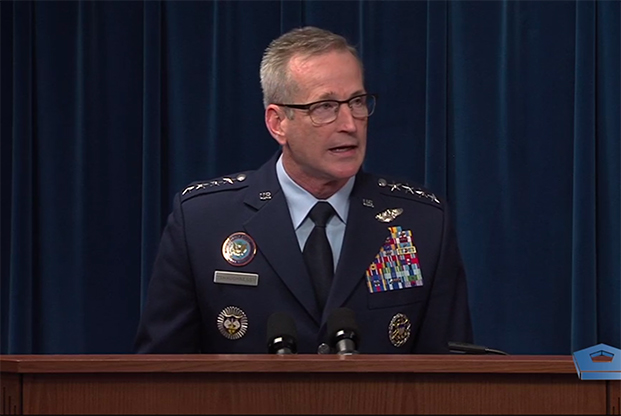
Air Force Gen. Terrence O'Shaughnessy, commander of US Northern Command and North American Aerospace Defense Command, speaks at an Oct. 29 press conference in Washington. DVIDS screenshot.
The Defense Department will send more than 5,200 Active Duty soldiers to the US-Mexico border as part of Operation Faithful Patriot, an endeavor supporting US Customs and Border Protection efforts to secure the boundary as caravans of would-be immigrants from Central America approach the US, the head of US Northern Command said Monday.
NORTHCOM Commander USAF Gen. Terrence O’Shaughnessy said in a joint CBP-DOD press conference in Washington that 800 of those personnel are already Texas-bound from Forts Campbell and Knox, in Kentucky, for training and will be available to deploy as needed. The rest should be in place by the end of the week, he added.
A C-17 assigned to the 3rd Airlift Squadron at Dover AFB, Del., and a C-130J from the 61st Airlift Squadron at Little Rock AFB, Ark., deployed in support of Faithful Patriot on Monday. The aircrew provided strategic airlift to soldiers from Headquarters Company, 89th Military Police Brigade, Task Force Griffin at Fort Knox.
Learn about the role of a C-17 from Dover AFB, Del., in Operation Faithful Patriot. Air Force video by TSgt. Laura Beckley.
In addition, a US Defense Department official with knowledge of the deployment told Newsweek there is “another 7,000” troops on 24-hour standby. For context, the US currently has about 15,000 troops deployed to Afghanistan.
This operation will complement— not replace—Operation Guardian Support, under which 2,092 National Guard troops are already mobilized along the border in support of CBP’s border-security mission, O’Shaughnessy said. As of Oct. 24, 150 of those personnel came from the Air National Guard.
O’Shaughnessy said Phase 1 of the effort will be hardening entry points to the US and addressing “key gaps” near them.
“In a macro sense, our concept of operations is to flow in our military assets with a priority to build up southern Texas, and then Arizona, and then California,” he explained. “We’ll reinforce along priority points of entry, so as to enhance CBP’s ability to harden and secure the border.”
According to O’Shaughnessy, the capability being sent to the border will include—but not be limited to:
- US Army Corps of Engineers
- 3 combat-engineering battalions and “heavy equipment” for them to use
- Military planning teams
- 3 medium-width helicopter companies
- Military police units
- Strategic airlift, including three C-130s and one C-17—all readily deployable
- Deployable medical units
- Logistical support
- Command posts
- Aviation assets
- Pre-positioned critical material
Additionally, he said, DOD has enough barbed wire to cover more than 172 miles of territory, between what’s already at the border and additional stock available.
The Department of Homeland Security enlisted DOD’s help because of the estimated size of these caravans, CBP commissioner Kevin McAleenan said during the press conference.
In addition to tracking a group of about 3,500 individuals “traveling through Southern Mexico with a stated intent to reach the US border,” he said CBP has learned of a second group of approximately 3,000 “family units and unaccompanied children who’ve placed themselves in the hands of violent human smugglers, paying about $7,000 per person to make the journey.” The latter group is currently at the Guatemala-Mexico border.
In the the past two weeks, CBP has “deployed 100 specially trained, special response team operators” to ready individualized plans for its 26 crossing sites along the border, McAleenan said.
“As information on the approach of a large group at a port of entry is available, we have, at the ready, 1,000 CBP officers, including 250 tactical-enforcement officers and mobile-response team professionals, with training on managing contingencies including riot control,” he said. “Between ports of entry, we have an additional 830 border-patrol agents on standby ready to deploy, to include 140 special operations agents, 385 mobile-response team agents, and an additional 350 agents from unaffected sectors.”
This CBP force will be backed up by more than 24 in-house air assets, including 10 helicopters—two of which are Black Hawks—plus “multiple fixed-wing assets and unmanned aerial systems” for help with “surveillance and mobile response.”